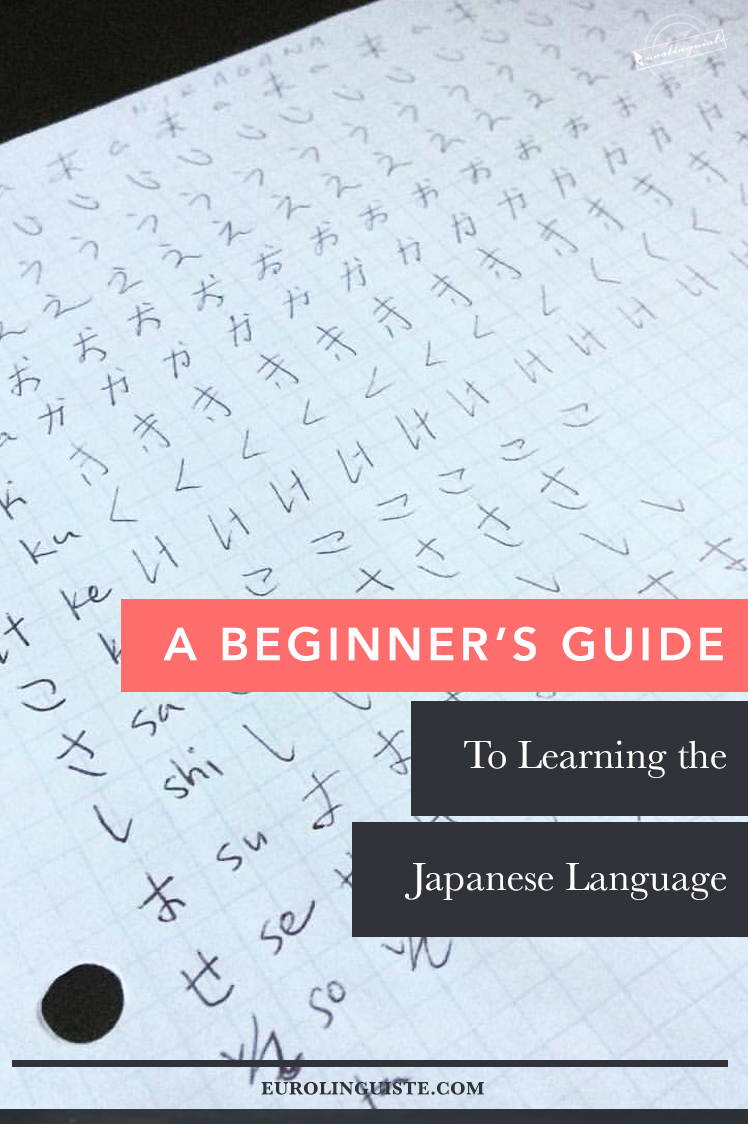A Beginner’s Guide to the Japanese Language

My name is Shannon Kennedy and I'm the language lover,…
Please note that this post contains affiliates. If you decide to purchase through one of these links, I will make a small commission at no additional cost to you. If you enjoy Eurolinguiste, please consider purchasing from our affiliate links to help support what we do! We will only ever recommend resources we believe in.
At first, learning Japanese can seem daunting. Not only do you need to learn three separate writing systems (four if you count romaji), but you have to deal with honorifics and particles.
Thankfully, there are several aspects of the Japanese language that aren’t nearly as challenging as your first impression may lead you to believe. Plus, there are a variety of high quality materials available to Japanese learners.
Having recently started studying Japanese, I’ve found myself evaluating a variety of resources and I wanted to share what’s working for me thus far.
Getting Started with the Japanese Language
Your motivation for learning Japanese may be one of any number of reasons. Some learn so that they can better understand the anime or manga that they enjoy, while others learn it to advance their careers.
Regardless of the reason behind why you’re taking on the Japanese language, you’re certain to find a number of areas you connect with. Whether it’s the rich music scene, the food culture, or booming economy, Japanese has a lot to offer.
Why Japanese Might Not Be as Hard as You Think
According to the Foreign Service Institute, Japanese is one of the hardest languages an English speaker could choose to learn. But rather than focus on why Japanese is hard, let’s take a look at why Japanese is easy.
Japanese has only two tenses – the present and the past.
These are often called non-past (present and future) and past. Context is usually used to determine anything more specific or to discuss the future. This is a nice number when other languages have you dealing with past, imperfect, subjunctive, or conditional tenses. None of those here!
You only need to worry about a limited number of irregular verbs.
And you can count these on two hands – at least those that you’ll use regularly. The two most common are to do する suru and to come 来る kuru.
You don’t need to worry about learning the plural forms of words.
In Japanese, you use counters so you don’t have to worry about the plural forms of words.
You don’t need to worry about learning gender.
In many Romance languages, you have to learn the gender of each noun (and then modify the adjectives to match). In Italian the blue sea is il mare blu, in French la mer bleue, and the Spanish say el mar azul. In Japanese it’s simply aoi umi 青い海.
Pronunciation of Japanese is straightforward.
Japanese phonology (its sounds) is, compared to other languages, simple. Each syllable is only pronounced one way and there are only five basic vowel sounds. Plus, you don’t have to worry about stress. This means that each syllable is given the same amount of time or emphasis, so it isn’t aRIgato, arigaTO, or ariGAto, but arigato.
There are tons of English loanwords that are used in Japanese. And equally, lots of Japanese words we use in English. It’s just a matter of modifying the pronunciation slightly. Here are just a few:
→ アイドル aidoru idol
→ アイスクリーム aisu kurimu ice cream
→ コンピューター konpyuta computer
→ コーヒー kohi coffee
→ ミルク miruku milk
→ モーテル moteru motel
And the reverse:
→ カラオケ karaoke
→ 大君 taikun tycoon
→ パン粉 panko
→禅 zen
→ 神風 kamikaze
→ 津波 tsunami
Japanese is a pro-drop language.
That means that you can often drop the subject if “who” or “what” is apparent from the context of the conversation. So instead of saying “I’m learning Japanese”, you can just say “learning Japanese”.
You don’t have to worry about an insane number of conjugations.
In Japanese, the verb doesn’t need to agree with their respective subject. This means that instead of trying to figure out how to say I study, you study, he studies, she studies. We all 勉強する – benkyosuru. Instead, you can spend your time focusing on formal forms and tenses.
Tips for Getting Started with Japanese
Learn to introduce yourself and a few basic phrases to start speaking right away.
Speaking from the start is a great motivator because it gives you a quick win with the language. Even if it’s nothing more than “Hello! I’m ____. Nice to meet you!” Speaking Japanese can be hugely rewarding. Here are a few phrases to get you started.
→Hello こんにちは Konnichiwa
→I’m ______. 私は_____です. Watashi wa _____desu. (You can insert your name or nationality here.)
→Nice to meet you. はじめまして. Hajimemashite.
→Goodbye さようならSayonara
Select a few materials to get started.
As I’ve mentioned in the past, this doesn’t need to be anything fancy. I highly recommend a course or course book of some sort because they offer structure. If you’re new to a language, this can be incredibly beneficial. I’ll list a few of the resources that I’m using below.
Study hiragana and katakana.
They each serve different functions and are a great way to start getting into reading and writing in the language. Plus, understanding how to read in a language also gives you a leg up on pronunciation. Why? Because romanization will never give you a 100% accurate representation of how the language sounds.
Find a way to practice speaking.
This can be a tutor, an exchange partner, or even just videos you create yourself. The goal is to get speaking practice in so that you can train your mouth to create the sounds necessary to speak Japanese.
Remember that consistent practice is key.
With a language like Japanese, one that is presumably very different from your native language, regular study is important. Why? For a variety of reasons, but consistent study gives you a better chance of:
1. Remembering what you’ve learnt
2. Spending less reviewing
3. Keep you from growing frustrated or overwhelmed
Recommended Resources for Learning Japanese
There is no one resource that will offer you everything you need to learn a language. Instead, aim to use a mix of resources, ensuring that you cover each of the core four skills that are most essential in terms of reaching your language goals. For example, if you aim to reach a conversational level, you’ll want to spend as much time speaking and listening as possible. If your goal is to read a comic book you enjoy, then the bulk of your time would be better spent with a course book and other reading material.
For Beginning Japanese Learners:
Master Japanese // This is an excellent book published by John Fotheringham. I used his Mandarin book several years back as well. Both are incredible resources for when you’re starting out.
FluentU (affiliate link) // FluentU is a fun and interactive platform that offers subtitles for a variety of video content. It’s available both as a mobile app and on your browser.
Japanese from Zero (affiliate link) // This is one of the most popular Japanese textbooks for independent learners. It’s known for it’s simple and straightforward explanations.
Japanese for Beginners (affiliate link) // I love the Tuttle course books, particularly because they have diverse options for learners of Asian languages.
Memrise // Memrise is my favorite app for learning vocabulary – whether it’s pre-created decks or your own personal decks.
Drops // A language learning game with extensive vocabulary lists and a beautiful interface. A great way to fill your downtime (sessions in Drops are five minutes).
JapanesePod101 (affiliate link) // A popular podcast with a ton of video and audio content for Japanese learners.
For Intermediate-Advanced Japanese Learners:
iTalki (affiliate link) // An online lesson platform with affordable teachers. The average professional Japanese tutor (at the time of writing) is around $15 USD per hour.
LingQ (affiliate link) // My favorite language learning app. Why? Because it gives me the chance to do the only other thing I love as much as languages – reading in my target languages.
Intermediate Japanese (affiliate link) // Another great publication and course book from Tuttle Publishing.
Glossika (affiliate link) // An audio-based learning platform that teaches through repetition.
Assimil (affiliate link) // My favorite course book. It’s based on translation, but there are also tons of exercises, useful vocabulary, culture tidbits, and audio.
For more recommendations, check out my Japanese resources page.
That’s it!
I hope that you’ve enjoyed these tips for learning Japanese. I’m really excited to take on this language and share my progress with you.
If you have any resources or tips for Japanese, I’d love to hear them in the comments below.
My name is Shannon Kennedy and I'm the language lover, traveler, and foodie behind Eurolinguiste. I'm also the Head Coach of the Fluent in 3 Months Bootcamp, co-founder of Women in Language, and former Resident Polyglot at Drops.



